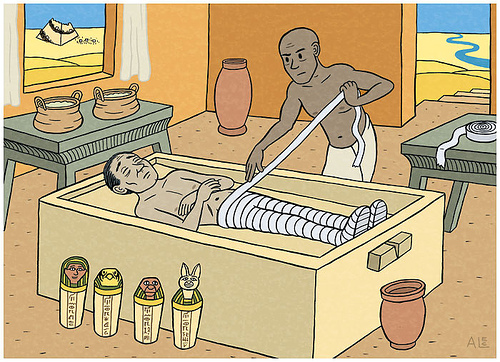An
underworld myth is one that explains what happens when someone dies. It
includes where they will go, what they will have to do to get there, and what
should be done with their body.
The
Egyptians believed that when someone died, they went to Duat. Duat was where
all the dead lived. They also believed that Duat was the home of the gods. The
Egyptians also believed in things they called the Ka and Ba. These were like
the soul and body of a person. Duat was also the place of many Egyptian myths.
.jpg) |
| Priests covering the body in salt. |
In
the meantime, the organs were put in special containers called canopic jars.
These canopic jars had the heads of gods on the lids. These gods were said to
protect the organs.
 |
| A priest wrapping a body with the
four canopic jars in the front
|
The
funeral was where the Egyptians prepared the Ka. The funeral procession would
begin early in the morning. The coffin was placed on a boat and rode down the Nile
River. It was then placed on a sled and dragged to the tomb. Along the way the
path was lined with Kites who were paid by the family to mourn. Shabties, or
small statues of the diseased, rode along with the body. They were believed to
become servants of the diseased in the afterlife. A statue of the diseased was also brought to
the burial site along with many animals. These animals were killed and offered
to the diseased.
 |
| This shows a funeral procession. To the left of the diseased are Muhu Dances. In front of the body there is a Kite. On the boat there are two Shabties. On the right there is the Sem. |
Once
the diseased reached the tomb, the head priest, called the Sem, touched the
mouth of the diseased with a special instrument, called an ur-heka, in order to
wake up the Ka and prepare it for burial. At the tomb, there were Muhu Dancers
who danced as the coffin was placed in the tomb. The canopic jars, containing
the organs, were also placed in the tomb. After the tomb was closed, there was
a festival.
The
care of the dead by the living did not end when the tomb was closed.The
Egyptians believed that the body still needed sustenance after it died for its
journey to the underworld. Offerings were made every day.
 |
| This a picture of a person getting their heart weighed on the scale of Ma'at. Under the right side of the scale is Ammit. |
Duat
had the same terrain as Egypt except there were lakes of fire and iron
mountains instead of lakes of water and mountains of sandstone. There were also
servants of the gods in Duat that were not from earth and did not harm anyone.
The Egyptians believed that when the sun set, it went to Duat, and then crossed
Duat and rose again the next day. In this land is where the Egyptians would
spend the rest of eternity.
 |
| The Pyramids at Giza were built for Egyptian Pharaoh's trip to the aferlife |
 |
| A Egyptian statue of Ma'at |
The myth of Duat is found in egyptian lituature. Many of Egypts famous writing had parts that tell about Duat. Art was also affected and there are many statues and shrines for Duat and the gods of it. Even before people died they still made offerings to the gods of duat. The last thing that the myth affected is the Egyptian economy. The building of the pyramids gave thousands of Egyptians work so that they could buy things and keep the economy running smoothly.
| President Abraham Lincoln's tomb. |
The Egyptian underworld myth not only effected ancient Egyptian society but also effected history.
Works Cited
"Ancient Egyptian Duat." Duat the Egyptian Underworld. Web. 3 Sept. 2014.
<http://iml.jou.ufl.edu/projects/fall04/hilton/underworld.htm>.
Egyptian Funeral Procession. N.d. http://factsanddetails.com/media/2/20120215-Funeral.jpg.
"Duat." Wikipedia. Wikimedia Foundation, 9 Jan. 2014. Web. 3 Sept. 2014.
<http://en.wikipedia.org/wiki/Duat>.
Drying a Mummy in Salt. N.d. http://3.bp.blogspot.com/-
byMqd4zWXcE/UOad9VxkGPI/AAAAAAAACNM/WPYYgtPLmb4/s320/mummification+
(18).jpg.
Gold Statue of Ma'at. N.d. http://www.ravensmist.com/assets/images/sm370.jpg.
Lincoln's Tomb. N.d. http://upload.wikimedia.org/wikipedia/commons/b/ba/Lincoln's_Tomb.JPG.
The Pyramids of Giza. N.d.
http://cdni.condenast.co.uk/646x430/g_j/giza_cnt_30mar10_iStock_b.jpg.
The Scales of Ma'at. N.d.
http://3.bp.blogspot.com/-6KELomUNsrM/UGWNuEgra2I/BD5bX6PpGi8/s640/29.
gif.
Lincoln's Tomb. N.d. http://upload.wikimedia.org/wikipedia/commons/b/ba/Lincoln's_Tomb.JPG.
The Pyramids of Giza. N.d.
http://cdni.condenast.co.uk/646x430/g_j/giza_cnt_30mar10_iStock_b.jpg.
The Scales of Ma'at. N.d.
http://3.bp.blogspot.com/-6KELomUNsrM/UGWNuEgra2I/BD5bX6PpGi8/s640/29.
gif.
Wrapping a Mummy. N.d.
http://ancientegyptrelgion.synthasite.com/resources/2197447039_c4ebcbc577.jpg.
No comments:
Post a Comment